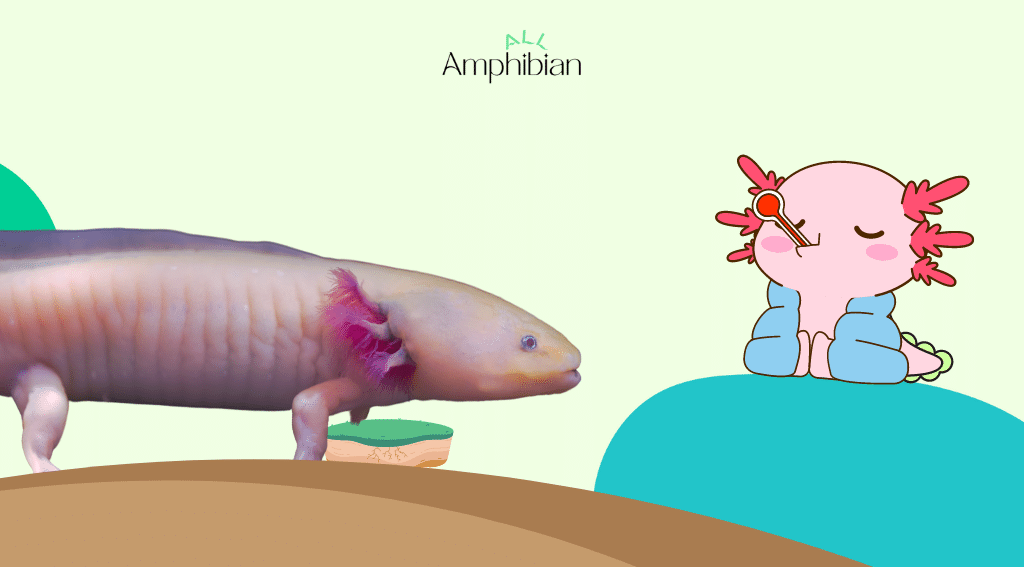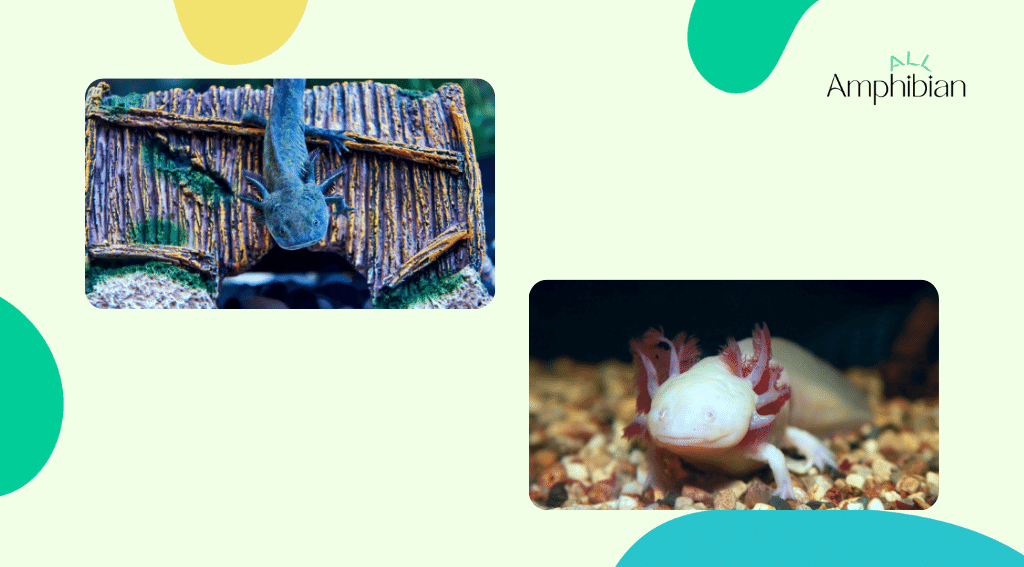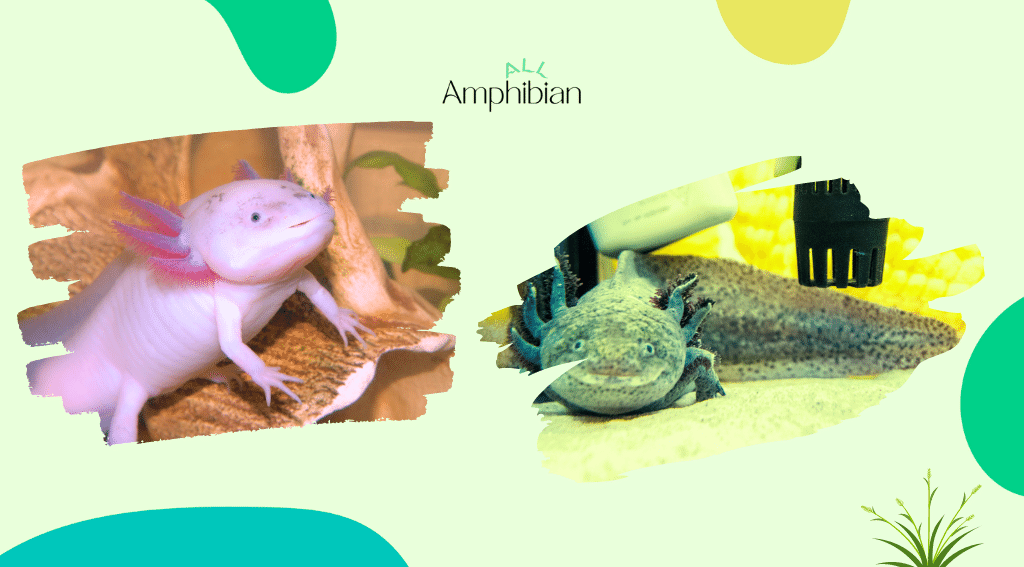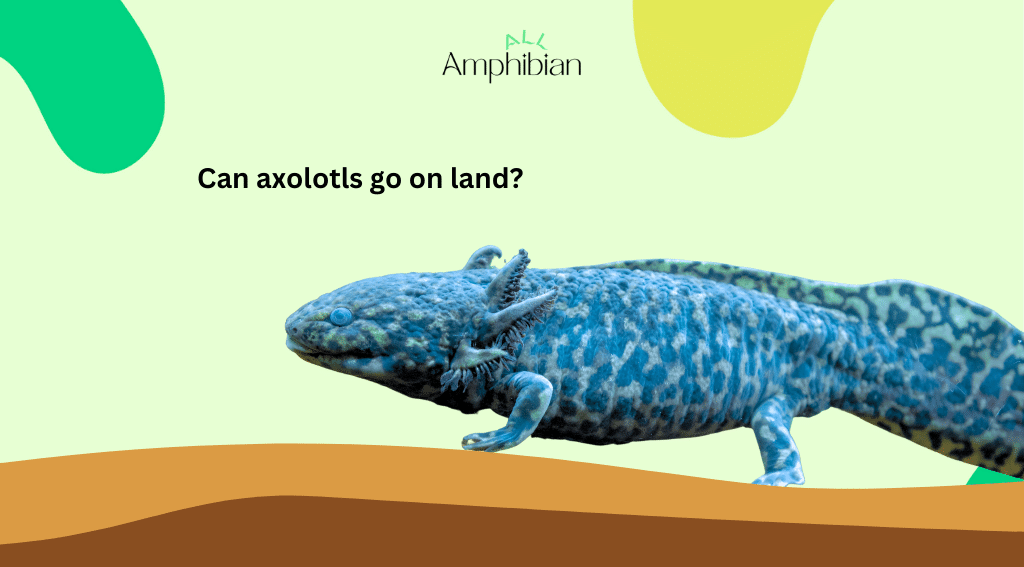Can axolotls go on land? Axolotls are amphibians, and amphibians can live on land and in water. But did you know that axolotls are different from other amphibians and cannot live on land like them? Stay with us at All Amphibian to investigate this case.
Can axolotls go on land?
Axolotls are amphibians. Amphibians are animals that have a two-stage life. They start their life in water and are aquatic. But over time, they undergo extensive changes and find the ability to live on land. These changes are called metamorphosis.
After metamorphosis and when they mature, they acquire the ability to live on land and can go to land. But axolotls are different from other amphibians. They never reach maturity and cannot completely pass the first stage of their life. Axolotls are neotenic. It means that they always remain young, and their bodies do not reach full maturity.
For this reason, they cannot live on land, and their life is completely spent in water. Of course, they still have lungs and can breathe through the air. But they can only survive on land for a while and cannot live on land.
Can axolotls live on land?

As we said, axolotls are neotenic. That is, they reach maturity without metamorphosis from the larval stage and can reproduce. Axolotls never lose their feather-like gills and fin-like tail. Therefore, they are not suitable for living on land and are compatible with living in the water.
For this reason, axolotls always live in water. They undergo an unusual metamorphosis. Their arms and legs are formed, but they are not strong enough for an axolotl to walk on land with them and are more suitable for swimming. Also, they have lungs, but their lungs are not developed.
Axolotls can breathe outside the water, but they cannot get all the oxygen they need. They can survive out of water for a short time but cannot live out of water. For this reason, it is recommended not to remove them from the water as much as possible, and if you do, try to return them to the water as soon as possible.
Do axolotls go on land?
Axolotls do not go on land in the wild, and there are no reports of them being seen on land. Although axolotls can survive on land for some time, they live entirely in water, like fish. But In captivity, axolotls are taken out of the water once in a while because their tank water should be changed every so often.
Usually, their owners take the axolotls out of the water for a while when changing their tank’s water. It is also very common for axolotls to jump out of their tank. Many times they even hurt themselves by doing this. The reason for this is not clear yet, and it is better to put a cover on the voxel tanks. But surely, there will be openings for air to pass.
How long can axolotls last out of water?

Axolotls have lungs and can breathe out of water. They can last from an hour to a few days out of the water, but It depends on the environmental conditions, age, and resistance level of axolotls. They last longer in dark and humid environments. But it is recommended that you never leave them out of water for more than a few minutes. Because they may be able to last longer out of the water, but this will damage them. Dry and hot conditions are very harmful to them because it makes their skin dry.
What happens if axolotls stay out of water for too long?
Axolotls are sensitive animals and are severely damaged if they are out of water for a long time. It may even kill them. The problems that may arise for them are:
- Stress
Axolotls are very sensitive to changes in environmental factors such as light, sound, and vibration, and they quickly suffer from mental problems. Taking axolotls out of the water also causes them to leave their safe environment and become stressed. In some cases, stress even causes the death of the animal.
- Diseases
The skin of axolotls is very sensitive. A slime coat covers the skin of the axolotl’s body. This substance, like fish scales, is a type of protection for their skin. It protects the axolotl from the penetration of bacteria and viruses and getting sick. Outside of the water, this slime coat dries up and disappears, and as a result, pathogenic substances can enter the axolotl’s body.
- Dehydration
outside of water, the slimy substance that covers the skin of axolotls keeps the axolotl’s skin moist. If axolotl stays out of water for too long, its slime coat will dry out and causes dehydration in axolotl.
- Respiratory Problems
Axolotls receive most of the oxygen they need through their gills and skin, and for this, their gills and skin must be moist. If they stay out of the water for too long, their body surface will dry, and the lack of moisture will cause the gills and skin of the axolotl to not be able to absorb oxygen properly, and the axolotl will have breathing problems.
Keeping the axolotl out of the water even for a short time may cause damage to this animal. It is strongly recommended not to do this as much as possible in times like cleaning their tank when you have to do this. Be sure to put them in a small container of water and return them to their tank after finishing the work.

How do axolotls breathe?
Amphibians usually breathe in different ways. Adult axolotls, like most amphibians have four methods of breathing.
■ Breathing through the skin
The skin of axolotls has a slimy membrane that keeps it moist and filters oxygen. They have an extensive network of blood vessels that absorb oxygen from the water when it comes in contact with the axolotl’s skin and release carbon dioxide. Then the oxygenated blood goes directly to the heart and spreads throughout the body.
■ Feather-like gills
The gills of the axolotl is one of the reasons for the attractiveness of this animal. They are seen as purple feathers on both sides of the axolotl’s head. Their feather-like shape increases the contact surface with water, resulting in higher gas exchange. These feathers contain blood-filled capillaries that bring carbon dioxide into the water and absorb oxygen. Also, these feathers are like rakes and prevent the penetration of bacteria into the axolotl’s body.
■ Buccal respiration
Axolotls have a kind of membrane behind their throat called a buccopharyngeal membrane. Its surface acts just like the skin of an axolotl and absorbs oxygen in contact with water.
■ Lungs
Like other amphibians, axolotls have lungs and can receive oxygen directly from the air. But their lungs are very primitive and not that efficient. Axolotls cannot get the oxygen they need through their lungs. The axolotl’s lungs are their weakest and last way of breathing.
Only when the oxygen level of the water is low do they come to the surface and swallow air. Also, they are playful animals and often do this for fun. They come to the surface and gulp air. This air in their lungs causes the axolotl to float in the water, and they may do this several times playfully.
Can axolotls walk on land?
Axolotls are a type of salamander, and salamanders can move on land with their legs and hands. But the axolotl is different from other salamanders. Their hands and feet are not like other salamanders because they are aquatic and live their whole life in water.
For this reason, their hands and feet are more useful for swimming. Between their toes, there is a membrane that helps the axolotl to swim. Also, they walk on the bottom of the water, but their arms and legs are not strong enough to walk on land.
Due to the characteristic of water that reduces some of their weight, the hands and feet of axolotls are not able to bear the full weight of the axolotl. For this reason, the axolotl cannot move well on land. They try to move but just crawl around a bit. You should never force an axolotl to move out of the water as this will cause them to injure themselves.
The skin of the axolotl is very sensitive, and because they cannot walk well, they have to crawl around, and this causes damage to their legs, arms, lower abdomen, and tail. In addition, like other salamanders, axolotls do not lose their tail, which is like a fin, and their tail also prevents them from moving around on land.
Summary
Axolotls are a unique type of amphibian. Like other amphibians, they start their life in water, but they do not undergo complete metamorphosis; because of this, they are different from other amphibians. Axolotls never leave their larval stage. They always remain young until the end of their lives and retain their youthful characteristics, which is called neoteny.
They always live in water. Like other amphibians, they also have lungs, but their lungs are primitive and cannot supply all the oxygen needed by the axolotl. For this reason, axolotls last a short time outside the water and cannot live on land. Axolotls get the oxygen they need in four ways.
In addition to lungs and gills, they can also breathe through their skin. Also, they have a membrane at the back of their throat that can absorb oxygen, and this type of breathing is called buccal breathing. Axolotls have a layer of slime on their skin that protects their skin, like fish scales.
This layer prevents bacteria and viruses from entering the axolotl’s skin; it also keeps their skin always moist and helps absorb oxygen. If the axolotl stays out of the water for a long time, it will suffer from stress, dehydration, illness, and breathing problems. Outside the water, if the slimy layer on their skin dries, harmful substances and bacteria will penetrate their skin.
Also, the axolotl is dehydrated and cannot breathe well due to dry skin. Axolotl’s hands and feet are not suitable for walking on land and are more adapted to life in water. It is recommended not to remove the axolotl from the water as much as possible because even for a short time, the animal will be harmed.

FAQ
▪︎ Can axolotls go on land?
Axolotls are amphibians, but due to their incomplete metamorphosis, they are adapted to live in water and cannot survive on land for a long time.
▪︎ Can axolotls live on land?
Axolotls cannot live on land because their lungs are not developed and cannot provide all the oxygen they need. They can only stay out of the water for a short time, but they cannot live on land.
▪︎ Do axolotls go on land?
In addition to gills, axolotls have lungs and can breathe on land, but they have never been seen out of the water and always live in water. In captivity, their owners take the axolotls out of the water for a short time to clean and change the tank water. It is also very common for axolotls to jump out of their tank in captivity.
▪︎How long can axolotls stay out of water?
It depends on the environmental conditions, age, and resistance of the axolotl. They can stay out of the water for one hour to several days. Axolotls can stay out of water longer in dark and humid environments.
▪︎ what happens if an axolotl stays out of water for too long?
If the axolotl stays out of the water for too long, it gets stressed. Also, if the slimy layer on their skin dries, bacteria and viruses can penetrate the skin of the axolotl and also causes respiratory problems in them. The risk of dehydration also threatens the axolotl.
▪︎ How do axolotls breathe?
Axolotls can breathe in four ways. They can breathe by using their feather-like gills and lungs. Their skin also absorbs oxygen. They have a membrane at the back of their throat that absorbs oxygen and is called buccal breathing.
▪︎ Can axolotls walk on land?
The hands and feet of axolotls are more adapted to life in water and cannot support the weight of axolotls on land. On land, they can only crawl around a bit, which causes them to get hurt.

